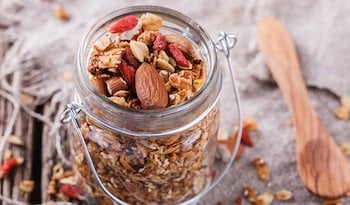Cassava Flour: A Comprehensive Guide with 3 Simple Gluten-free Recipes
DISCLAIMER:This blog does not intend to provide diagnosis...
- In this article:
- What Is Cassava Flour?
- Cassava Root, Tapioca, and Cassava Flour
- Cassava Flour's Health Benefits
- 4 Incredible Benefits of Cassava Flour
- Cooking With Cassava Flour
- 3 Gluten-Free Cassava Flour Recipes
- Cassava Banana and Strawberry Waffles
- Simple Cassava Flatbread
- Creamy Cassava Cake

Originally posted April 2019 / Updated July 2023
What Is Cassava Flour?
Cassava flour is a grain-free, gluten-free, low glycemic index flour made from the root of the cassava plant (Manihot esculenta). Native to South America, cassava is a tuber crop, like potatoes and yams, extensively cultivated, especially in the tropics. Cassava is a major food staple in many countries and provides the foundation of the diet of over 800 million people.
Cassava is often referred to as yucca, but that is not correct. Because cassava is called "yuca" in parts of South America, that has confused people into thinking that cassava is the same as the yucca plant (Yucca sp.). The two plants are not remotely similar, as they are from entirely different plant families. Cassava is a member of a flowering plant family, while yucca is a cactus-like succulent. Hence, Cassava root is not yucca root, and vice versa.
Cassava Root, Tapioca, and Cassava Flour
Many people are familiar with cassava root as the source of tapioca. Cassava flour is made from the entire ground root, whereas tapioca is composed of only the starch of the root. Tapioca flour is simply ground tapioca.
Cassava flour is higher in fiber and is more functional than tapioca flour in that it can be used in place of corn, wheat, and other grain flour in most recipes.
Cassava flour has a mild flavor, light color, and powdery texture, making it an extremely close substitute for wheat flour. It does not tend to overpower the recipe, and some people even say they can hardly even tell the difference between cassava flour from conventional flour in recipes.
Cassava Flour's Health Benefits
One significant health benefit of cassava flour is that it does not raise blood sugar levels as high as other starches like rice, potatoes, pasta, and bread made from wheat and other grains.
Much of the starch in cassava flour (and tapioca) is resistant starch. This type of starch does not get digested and absorbed into the body. It is a great prebiotic to feed health-promoting bacteria in the small and large intestines. Not only does that improve digestive health and the intestinal microbiome (collection of gut microbes), but it also is very important in improving blood sugar control and cardiovascular health.
Cassava flour also has 3 grams of fiber per quarter cup (compared to all-purpose wheat flour, which has only 1 gram of fiber per quarter cup). Products made entirely or a high percentage of cassava flour with other flours can be a good choice for people with diabetes if consumed in moderate amounts. Cassava flour has a glycemic index score of 46, making it lower than wheat flour (85) and foods like potatoes (78) and rice (70).
4 Incredible Benefits of Cassava Flour
Cassava flour is often used for people who want to avoid gluten, wheat, or other flour sources. Cassava flour is unique because it is a flour that doesn't tend to trigger most allergies. This includes people with nut allergies and those who cannot use almond or coconut flour. It is also grain-free and easy on the digestive system. As mentioned above, cassava flour supports digestive health.
Some of the many reasons that make cassava flour such a good substitute for wheat flour include the fact that it's:
- Cassava flour is gluten-free: While flours from gluten-containing grains like wheat and rye contribute to problems such as leaky gut and inflammation, cassava is a completely gluten-free option. This can make it a better choice for families and those with sensitive systems. It can also be important for people with autoimmune triggers to reduce common allergens and food irritants.
- Cassava flour is low in sugar: Cassava flour is lower in sugar and has a much lower glycemic index making it quite helpful if someone has diabetes or is trying to watch their blood sugar. It is very important to know which foods have a low glycemic index. Many types of flour and bread can spike their blood sugar even if they don't contain a lot of sugar. The bottom line is that cassava flour is a low-sugar alternative that can help blood sugar levels stay stable.
- Cassava flour is easy to digest: For those who struggle with irritable bowels or other digestive issues, cassava flour is often greatly appreciated. It is gentle and easy to digest, presenting a non-irritating alternative to flours that tend to aggravate digestive problems. In addition, cassava flour helps to promote healthy gut flora and reduce bacterial imbalances by providing dietary fiber and resistant starch that act as beneficial prebiotics.
- Cassava flour is allergen and grain-free: Cassava flour is a low-allergen food. As a result, it can be a lifesaver for people with food allergies or sensitivities.
Cooking With Cassava Flour
Traditionally, cassava flour is most commonly used to make flat cakes that do not rise. However, cassava flour can be used to replace wheat flour in most recipes. For additional health boosts, it is suggested that cassava flour is paired with other nutrient-dense ingredients to give a recipe a power-up. Flax meal and chia seeds are popular for adding supplemental nutrition and fiber to a dish. The color and texture of cassava flour are similar to white potatoes, so it generally produces an attractive mouth-feel and appearance when replacing conventional flour in recipes.
3 Gluten-Free Cassava Flour Recipes
Those wondering where to find a good cassava recipe needn't look any further. Here are three tasty cassava flour recipes to try.
Cassava Banana and Strawberry Waffles
Ingredients:
- 1 cup cassava flour
- ½ tsp. sea salt
- 2 tsp. baking powder
- 1 ripened banana
- 1 cup chopped strawberries
- 2 eggs
- 1 tsp. vanilla extract
- 2 Tbs. coconut oil
- 1½ cup nut milk or water
Instructions:
- Preheat waffle iron.
- Place ingredients in a blender.
- Blend about a minute until smooth.
- If the batter is too thick to pour, add more milk or water.
- Pour batter into waffle iron, allowing extra time to cook to ensure centers are thoroughly done.
- When outside is crispy and brown, remove from the waffle iron.
- Add strawberries to the top and enjoy!
Simple Cassava Flatbread
Ingredients:
- 1 cup filtered water
- 3 cups cassava flour
Equipment:
- Pizza hoop
- Stovetop pot or pan
- Measuring cup
- Tablespoon
- Stirring spoon
- Potato masher
Instructions:
- Measure flour and add to large mixing bowl.
- Gently pour water in while stirring to mix ingredients thoroughly. The result will be a grainy texture.
- Break up the lumps with a spoon or by hand to achieve a fluffy consistency
- The mixture is now ready to be baked.
- Heat pan to medium heat and place a pizza hoop in the center.
- Transfer 9 heaping tablespoons of the mixture into the heated pan. Evenly spread the mixture across the bottom of the pan, pressing the flour down into place.
- As the mixture cooks, use a potato masher to press down the mixture firmly, carefully concentrating on the outer edge of the bread.
- Let it bake about four minutes until the edges lift from the sides of the pan.
- Remove hoop and turn the cassava bread carefully.
- Cook opposite side an additional three to four minutes.
- Remove bread, allow to cool and enjoy!
Creamy Cassava Cake
Ingredients:
- 2 cups cassava flour
- 1 can (14 ounces) sweetened condensed milk (separate 1/3 cup for topping)
- 1 can (12 ounces) evaporated milk
- 1 can (14 ounces) coconut milk (separate 1/3 cup for topping)
- 1 can (12 ounces) coconut cream (separate 1/3 cup for topping)
- 2/3 cup coconut sugar
- 3 eggs
- 3 egg whites
- 3 egg yolks (set aside for topping)
- 1 cup grated coconut
Instructions:
- Preheat oven to 325 degrees Fahrenheit.
- Combine ingredients for the cake (setting aside ingredients for topping) in a large mixing bowl.
- Stir well, removing any lumps.
- Grease two rectangular-shaped pans and distribute batter equally between the two.
- Bake dishes for approximately 30 minutes or until mixture solidifies.
- Mix together ingredients for the topping and pour on top of cakes.
- Bake cakes for another 20 to 30 minutes.
- Allow cakes to cool completely.
- Slice into squares and enjoy!
References:
- Wen JJ, Li MZ, Nie SP. Dietary supplementation with resistant starch contributes to intestinal health. Curr Opin Clin Nutr Metab Care. 2023 Jul 1;26(4):334-340.
- Maiya M, Adorno A, Toulabi SB, et al. Resistant starch improves cardiometabolic disease outcomes: A narrative review of randomized trials. Nutr Res. 2023 Jun;114:20-40.
- Okafor EN, Erukainure OL, Ozumba AU et al. Cassava Flour Substitution Modulates Glycemic Responses and Glycemic Index of Wheat Breads in Apparent Healthy Volunteers. J Diet Suppl. 2017 Jul 4;14(4):446-452

 By Dr. Michael Murray, N.D.
By Dr. Michael Murray, N.D. 


